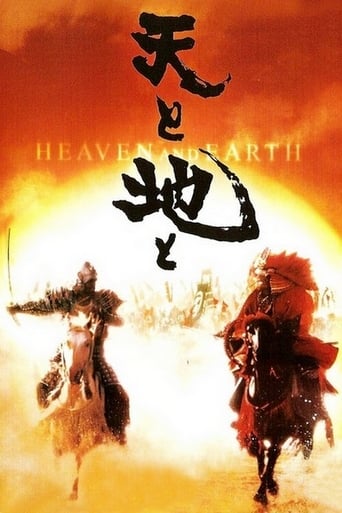Mike Richards
I happened to get a chance to see Ten To Chi To or Heaven And Earth, as we knew it here, on the big screen when it debuted in Calgary in the spring of 1990. After having worked many long hours on the movie for a good part of the late summer in 1989 as one of the 2000 Samurai infantry extras, it was amazing to see the finished product on the big screen. As mentioned in one of the earlier reviews, for fans of the Samurai movie genre, this is a must see. The large battle scenes are spectacular.Trivia note. Actor Ken Watanabe was originally cast as one of the lead actors in Heaven and Earth. While filming Ken was diagnosed with acute myelogenic leukemia, a life-threatening disease of the bone marrow, that put an end to his part in the movie. Ken had to return to Japan for treatment that kept him away acting for a few years. He came back in 1994 only to have a relapse, but once again battled back. Ken has been nominated for Best Actor in a supporting role at this year's Academy Awards for his outstanding performance as Katsumoto in The Last Samurai. I wish him all the best! BTW, I was one of a handful of extras who worked all through the filming from July to early Sepetebmber 1989, here in Alberta. During the last few days of filming there was only about 50 or so of us left. On the final day, final scene, a Saturday afternoon IIRC, some production people came around and handed each of us a cold beer. Director Haruki Kadokawa came out and toasted us. He smiled and said, "Very long. Very hard. Thank you!"
JimB-4
It is difficult to imagine a more visually stunning film than this one. The landscapes and skies are beyond beauty, and the massive battle scenes dwarf anything I've ever seen, even perhaps Bondarchuk's "War and Peace." This is one of the first films I've seen that conveys a believable sense of thousands (rather than hundreds or dozens) of soldiers in simultaneous combat, and the color-coded armies are both amazing to consider as fighting entities and astonishing to watch as masses of moving color and light. The final half hour is one of the most amazing feats of logistics and color ever put to film. Now if only there were a story worth following. Basically, there are two armies and the two armies fight or pursue each other. There is a minor attempt at personalizing the leaders of each army, but it all seems merely a formality, and a very unsuccessful one. There are no characters such as found in the great war movies, either in small films like "A Walk in the Sun" and "Nobi" ("Fires on the Plain") or in epics like "Ran" or "The Longest Day" or "Lawrence of Arabia." No, we're just told (I repeat told; I refer to the English-narrated version) that these people have enmity one for the other and that there is reason for battle. Then we watch the battles (or more often, the planning sessions). When battle comes, it is spectacular beyond expectation. But in the end, no one, not even the filmmakers it seems, cares who won or whether anyone did.
bleeroy
This movie was great. The cinematography, battle scenes, story line, and costumes are grade A. One of my favorite war movies of all time, without a doubt. If your looking for historical accuracy, watch the history channel or a documentary. People who put this movie down because of historical deviations are probably the same type of people who watch terminator, going "that goes against all rules of physics", through half of the movie instead of just enjoying it for what it is.If you like war movies, Japanese movies, big battle scenes, samurai movies, etc. then this is a definite must watch.
icky0
Sure, it might not be historically perfect - but that's not why I watch movies. I watch movies to be entertained, and this movie provides entertainment by the bucketload.The cinematography is incredible, the story is great, and the war scenes are like none other.Definitely one for your movie library!


